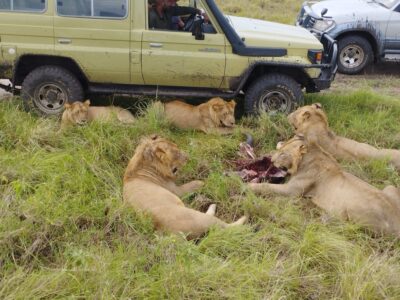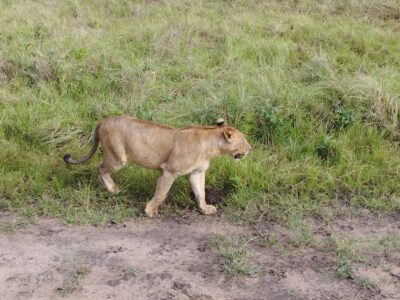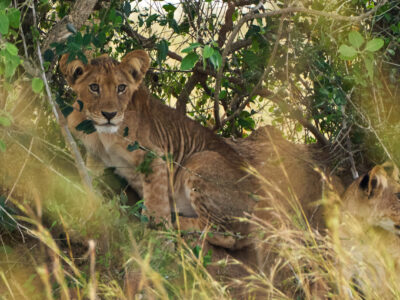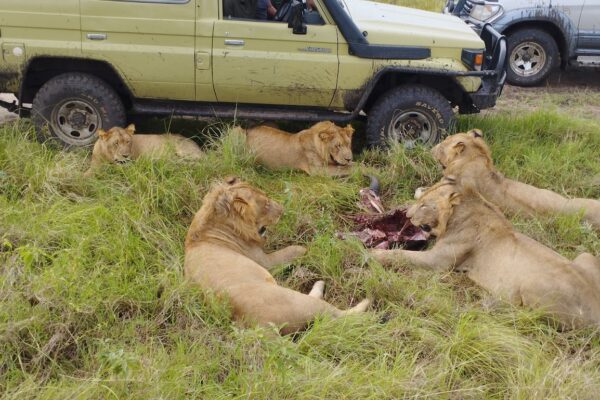Lion Tracking Expert Guide In Queen Elizabeth National Park
The remarkable Lion Tracking Expert Guide In Queen Elizabeth National Park. Visit Uganda for Lion Tracking Safaris & Tours In Africa. Lion Tracking promises a once-in-a-lifetime time adventure for wildlife lovers and Big 5 viewers. In Uganda, the lion tracking experience takes you to Queen Elizabeth National Park which is the most visited national park in Uganda for an astonishing wildlife encounter. In Uganda, Queen Elizabeth National Park is among the best national parks to encounter a true African Safari. The park is situated in Western Uganda and was established to be a protected area in 1952. The park is characterized by a remarkable landscape consisting of extensive savanna grasslands, woodlands, plains, crater lakes, gorges, forests, and mountain Rwenzori in the background. Queen Elizabeth National Park is home to 95 mammals and close to 600 bird species. The mammals at Queen Elizabeth National Park include elephants, leopards, lions, buffaloes, and hyenas among others.
Queen Elizabeth National Park is a lion conservation unit and thus lions are a leading attraction in the park. The park is home to over 250 of the enormous cats in both the northern and southern sectors. The park is among the best places to experience lions in Africa. Besides the normal lions, Queen Elizabeth National Park is most prominent for owning the greatest population of tree-climbing lions in the world. The tree climbing lions are located in the Ishasha sector which is in the southern sector of the park. During an ordinary game drive in Ishasha, tourists can see the lazy lions hanging on large fig trees.
Although seeing tree climbing lions during a game drive in Ishasha is considered to be among the climax of a safari in Queen Elizabeth National Park. Lion tracking experience is an activity that is even more interesting and it is open. Tourists Get a chance to see the Three-Legged Invincible Lion. The lion tracking experience in Uganda can only be done at Queen Elizabeth National Park. This activity is only carried out in the northern sector of Queen Elizabeth National Park (Kasenyi Plains). Lion tracking is among the must-do activities in Uganda and gives tourists a golden opportunity to get close to the lions in their natural environment, unlike normal game drives. It includes closely following lions to acquire more knowledge of their ways of life, natural environment, and feeding habits. The activity is headed by professional and well-informed researchers from the Uganda Carnivore Program. By paying to participate in the lion tracking experience, tourists can be sure to enjoy a worthwhile wildlife conservation initiative.
Uganda Carnivore Program – Wildlife Conservation and Research Tours
The Uganda Carnivore Program (UCP) is under the research department of the Uganda Wildlife Authority. The program started in the 1990s and was formerly referred to as the Uganda Large Predator Project. The Uganda Large Predator Project began out of concern that a pandemic (the canine distemper Virus) that was eliminating canines in the Serengeti National Park would circulate to predators in Uganda. The fright amongst conservationists in Uganda was constituted by several lion deaths of undisclosed causes. Following some research, it was discovered that the cause of death of lions in Uganda lions was not the distemper virus but were poisoned. A conclusion was made to carry on with the project to observe and research predators in the park. In due course, the project enlarged to include community conservation and other activities. As new partners were brought on board in aid of the project, the project changed its name to what is currently known as the Uganda Carnivore Program.
The Uganda Carnivore Program concentrates on conservation and research. The program eradicates communities surviving near the park on the significance of wildlife and how they can survive in peace with the big cats. Queen Elizabeth National Park is huge but has several human settlements inside and outside the park borderline. Furthermore, a key main road transits through the northern sector of the park. Nearly all of the communities neighboring the park rely on farming and looking after domestic animals. These animals frequently feed deep inside the park borderlines and into lion territory. Therefore, there are bound to be experiences and even conflicts with park predators.
So as to safeguard and monitor the movements of the predators, the UCP has obtained present-day tracking devices that can help in the tracking of the predators. The project owns an all-inclusive database of nearly all of the predators in the Northern section of Queen Elizabeth National Park. This database along with others has assisted the conservationists and the government to know the total number of lions in the park.
Additionally, UCP also teaches young scientists, assists in migrating park animals, and makes recommendations that help government and global associates in making main financing resolutions and areas of focus. The project hosts global volunteers and student researchers interested is wildlife conservation/ecology.
So as to raise finances and increase project activities’ visibility, lion tracking was introduced in collaboration with the Uganda Wildlife Authority. In this arrangement, a microscopic number of tourists are allowed to go for day and night trips for a more detailed understanding of predators like leopards, hyenas, and lions.
The Uganda Carnivore project is headed by Dr. Ludwig Siefert and he has been with the project from the time it was initiated in the 1990s. Ludwig is also a lecturer at Makerere University. Dr. Ludwig has produced noteworthy contributions to wildlife research and conservation as a project director and a Makerere University professor. He has assisted in the attraction of project funding and assisted in the training of hundreds of scientists. Additionally, Ludwig assists with predator research in other national parks in Uganda.
How is Lion tracking in Queen Elizabeth National Park arranged?
The lion tracking experience in Queen Elizabeth National Park requires following an individual or group of lions to acquire more knowledge about their behavior, feeding habits, and social/group dynamics. To participate, in the lion tracking experience, clients must book in advance. The experience costs $60 per person for foreign residents and 100,000 Uganda shillings for East African residents. Payment can directly be made either at the Mweya visitor’s information Centre or more effortlessly through your tour operator. The park authorities give back $10 of each booking to the Uganda carnivores program. The above-mentioned price of the lion tracking experience excludes park entrance fees. A limited number of people may take part in the activity.
There are three lion tracking sessions in a day namely: the morning, afternoon, and evening sessions and each session takes at least two to three hours. If you have booked any of the three sessions, you must arrive on time. The chief tracker or researcher will give you a short briefing about the activity and what you should expect before you enter the vehicles to look for the lions.
Tracking lions in Queen Elizabeth National Park has been made achievable because of new advancements in tracking technology. Radio collars are carried on the predominant lioness of a pride. Lions are not selected because they normally go astray from the group to mark their territories. The lionesses live with the main group allowing the researchers to closely monitor all the other lions inclusive of the cubs and alpha males. Researchers choose to put a collar on a lioness that is not expecting, is old enough, and in perfect health. Once she is detected, a tranquilizer is used to make the lioness lose consciousness before putting the collar around the lion’s neck. It takes approximately 2 days for the lioness to get used to the collar. During the collar installation process, the researchers ensure that they are very comfortable and loose to make sure that the cat doesn’t get stuck while passing through thick vegetation.
The battery-powered collars send transmit frequencies which are always read by a GPS to point out the accurate location of the lions each time the frequency is dialed. The tracking device produces a beeping sound which escalades when the lion gets close. Lions make a lot of movements mainly if the game is rare. In case there exists adequate prey, their movements range from 40 square kilometers. In areas where food is scarce, their territory can go up to 400 square kilometers. The radio collars make it possible for researchers to keep track of the lion pride movement and know if they are either in good health or threatened by local communities close to the park.
During the lion tracking experience, the Researchers have to share information regarding their biology, habitats, and threats. You will acquire information in regards to the lions’ life span which is approximately 12 years. The major role of the male lions is protecting the pride and ensuring that intruders do not come into their territory. On average, a male lion delivers 3 cubs.
Tracking lions in Queen Elizabeth National Park is completely different from the normal game drive experiences. During ordinary game drives, vehicles are not allowed to get off their designated tracks/roads. During the lion tracking experience, the driver guide is allowed to drive off track and proceed deep into the savanna based on the lions’ location. As soon as the team gets close to the lions, the driver guide is supposed to switch off the engine to avoid scaring away the cats. On a lucky day, you might observe the researcher gathering DNA, blood, urine, saliva, ticks, and other samples from the lions after applying the tranquilizer.
In case you experience the entire pride; you will have a scarce opportunity to observe an up-close sight of the lion family. Observe the juveniles as they play while resting adults. Lions have unlike vocal signals to disclose agony or inform others about their current location. Lions are territorial animals. The territories are marked by a dominant male through digging holes with the help of their behind legs, rubbing their mane on shrubs, or urinating near the major trees in his territory. All the above-mentioned signs leave a lion’s strong smell to warn any potential intruders. Use the time to capture nice photos of the lions at a close distance. The dominant males head the lion prides and they are usually two or three in a pride. The males are characterized by black manes and are stronger than the females. Even though they are tinny, lionesses dominate a lot of what happens in the mainly because most of the hunting is done by them. Lionesses may appear small in size but can fight off males just to safeguard their cabs during any takeover.



Key facts about Lion tracking in Queen Elizabeth National Park
Lion tracking in Queen Elizabeth National Park is completely different from the ordinary game drive. The number of people who are allowed to participate in lion tracking is limited to avoid stressing out the cats. Having clients participate in lion tracking makes the experience more personal and enables clients to take better photos since the lions become comfortable and have fewer unnecessary movements. Furthermore, are less preoccupied when with a smaller group. and can share information more easily.
The studies are with lions in the northern sector of the park or the Kasenyi plains. There is a difference between these lions and the tree-climbing lions of Ishasha. Animals are more concentrated in The Kasenyi plains than in the Ishasha sector. During, lion tracking, you will see antelopes, elephants, and buffaloes, among others.
Besides lions, other predators like lions and hyenas are also studied by the Uganda Carnivore Project. On a lucky day, you might have an opportunity to track a second predator as you follow the lions. Participants in lion tracking might be requested to participate in research-related activities such as collecting samples or recording information about the cats.
You can reach Queen Elizabeth National Park either by air or road. Within and close to Queen Elizabeth National Park, there are three airstrips one in Mweya, another in Kasese, and the last one in Ishasha. Clients must book a flight either from Entebbe or Kajjansi to any of the three airstrips. Your tour operator or driver guide must wait for you at the airstrip and transfer you to the park headquarters for registration. In case you are traveling by road; you are required to drive from Kampala to Kasese. The transfer from Kampala to Queen Elizabeth National Park takes approximately 6 hours driving. If you have plans of combining lion tracking with other park activities, you need at least 3 days in the park.
In case you are asking yourself where to stay during your lion tracking experience, worry no more. There are several accommodation facilities available to choose from. These accommodation facilities range from luxury to midrange, and budget lodges. The best luxury lodges that are worth checking out are Ishasha Wilderness Camp, Buffalo Safari Lodge, Elephant Plains Lodge, Katara Lodge, and Mweya Safari Lodge among others. The midrange lodges include Aardvark Safari Lodge, lake Munyanyange Caves Lodge, Park View Safari Lodge, Elephant Hab Lodge, and Engiri Game Lodge among others. Budget lodges include Enshama Game Lodge, Topi Safari Lodge, Bush Lodge, Queen Elizabeth Safari Lodge, and Tembo Safari Lodge among others. It is also important to take into consideration that lion tracking in Queen Elizabeth National Park is done throughout the tear.
Other activities in Queen Elizabeth National Park
As earlier mentioned, Queen Elizabeth National Park offers many activities and things to do. Tourists can register for the three-hour Mangoose tracking along the Mweya peninsular to acquire more information about these mammals and their major enemy, the African cobra.
In case you are interested in acquiring more knowledge about the indigenous tribes of Uganda and their culture, you can visit one of the villages or communities around Lake Katwe. A boat cruise along the Kazinga channel will give you one of the best wildlife experiences in Africa. Be ready to see many hippos, crocodiles, buffaloes, elephants, water birds, and many of the other park animals drinking from the channel.

Uganda Safaris & Tours To Inspire You
- 1 Day Mgahinga Gorilla Trek
- 1-Day Murchison Falls Safari
- 3 Days Murchison Falls National Park Safari
- 3 Days Uganda Gorilla Trekking in Bwindi
- 5 Days Uganda Gorillas and Wildlife Safari Tour
- 5 Days Uganda Gorilla Trekking from Kigali
- 6-Day Remarkable Gorillas & Lion Tracking
- 6 Days Kidepo & Sipi Falls Safari
- 7 Days Epic Uganda Safari
- 8 Days Uganda Safari & Wildlife
- 8 Days Norther Uganda & Wildlife Safari
- 9 Days Great Apes of Uganda
- 10 Days Wildlife Uganda Safari
- 11 Days Masai Mara & Mgahinga Gorillas
- 12 Days Exclusive Uganda Wildlife
- 12 Days Exclusive Uganda Safari
- 13 Days Uganda Primates & Wildlife Safari
- 13 Days Uganda Primates and Tanzania Serengeti Safari
- 14 Days Best of Northern & Western Uganda
- 14 Days Rwanda Uganda Tanzania Safari
- 15 Days Best of Uganda Safari & Wildlife
- Slow Pace Itinerary for Seniors: Uganda and Rwanda
Travel Advice From JimJam Safaris
We cater to all ages, budgets, interests, and fitness levels. Our team can assist with queries about tours, Accommodations, bookings, and Affordable Luxury destinations. We will respond to your Inquiry as soon as possible. Our team of friendly and service-minded Safari Consultants is available to assist you in making a private personalized tailor-made Safari Itinerary and to answer all questions you might have. Are you dreaming of Wildebeest Migration? Gorilla Trekking in Africa? Honeymoon In Africa? or Africa’s Big 5 Experiences? Start Planning for Your Affordable Luxury African Safaris with JimJam Safaris & Tours Africa.